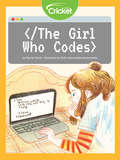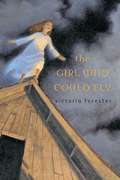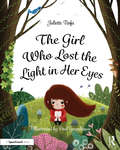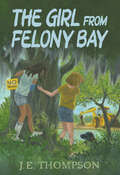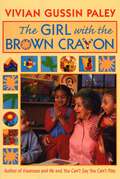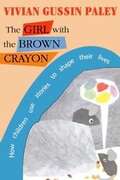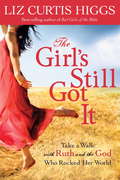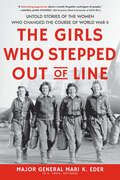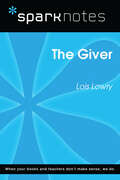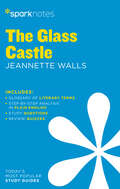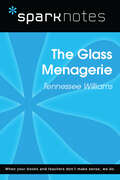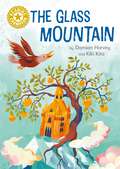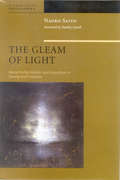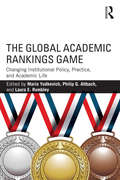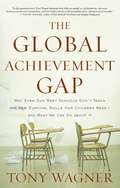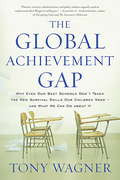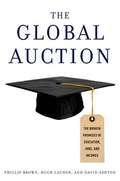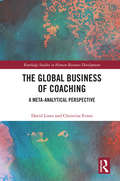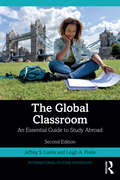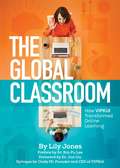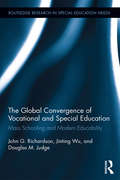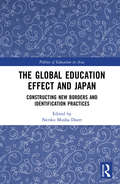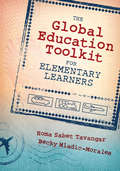- Table View
- List View
The Girl Who Codes
by Rachel SarahMae Foster is a young girl who loves to code! She is super excited to join her school’s Coding Club but feels guilty about leaving her sick mother at home. Can she figure out a way to continue coding and help her mother at the same time?
The Girl Who Could Fly
by Victoria ForesterYou just can't keep a good girl down . . . unless you use the proper methods. Piper McCloud can fly. Just like that. Easy as pie. Sure, she hasn't mastered reverse propulsion and her turns are kind of sloppy, but she's real good at loop-the-loops. Problem is, the good folk of Lowland County are afraid of Piper. And her ma's at her wit's end. So it seems only fitting that she leave her parents' farm to attend a top-secret, maximum-security school for kids with exceptional abilities. School is great at first with a bunch of new friends whose skills range from super-strength to super-genius. (Plus all the homemade apple pie she can eat!) But Piper is special, even among the special. And there are consequences. Consequences too dire to talk about. Too crazy to consider. And too dangerous to ignore. At turns exhilarating and terrifying, Victoria Forester's debut novel has been praised by Stephenie Meyer, author of the Twilight saga, as "the oddest/sweetest mix of Little House on the Prairie and X-Men. . . Prepare to have your heart warmed. " The Girl Who Could Fly is an unforgettable story of defiance and courage about an irrepressible heroine who can, who will, who must . . . fly. Praise for Victoria Forester and The Girl Who Could Fly: "It's the oddest/sweetest mix of Little House on the Prairie and X-Men. I was smiling the whole time (except for the part where I cried). I gave it to my mom, and I'm reading it to my kids--it's absolutely multigenerational. Prepare to have your heart warmed. " Stephenie Meyer, author of the Twilight saga "In this terrific debut novel, readers meet Piper McCloud, the late-in-life daughter of farmers. . . The story soars, just like Piper, with enough loop-de-loops to keep kids uncertain about what will come next. . . . Best of all are the book's strong, lightly wrapped messages about friendship and authenticity and the difference between doing well and doing good. "--Booklist, Starred Review "Forester's disparate settings (down-home farm and futuristic ice-bunker institute) are unified by the rock-solid point of view and unpretentious diction... any child who has felt different will take strength from Piper's fight to be herself against the tide of family, church, and society.
The Girl Who Lost the Light in Her Eyes: A Storybook to Support Children and Young People Who Experience Loss (Supporting Children and Young People Who Experience Loss)
by Juliette TtofaThis beautifully illustrated and sensitively written storybook has been created to be used therapeutically with children experiencing loss. Telling the story of a young girl who searches high and low for the light that is missing from her eyes, it encourages the child to move through the grieving process in order to find colour in the world again. The colourful illustrations and engaging story are designed to inspire conversation around loss, and will help develop emotional literacy and resilience in children and young people. This book is also available to purchase alongside a pocket guidebook as part of the two-component set, Supporting Children and Young People Who Experience Loss. The full set includes: • The Girl Who Lost the Light in Her Eyes, a colourfully illustrated and sensitively written storybook, designed to encourage conversation and support emotional literacy. • Using the Expressive Arts with Children and Young People Who Experience Loss, a supporting guidebook that explores a relational approach and promotes creative expression as a way through loss or bereavement. Perfectly crafted to spark communication around a difficult topic, this is an invaluable tool for practitioners, educators, parents, and anybody else looking to support a child or young person through loss or bereavement.
The Girl from Felony Bay
by J. E. ThompsonNo Trespassing signs pop up all around Felony Bay on the eastern coast of South Carolina. Someone is poking around a mystery, maybe the same someone who framed Abbey Force's dad for a terrible crime he didn't commit. This adventure takes middle readers on a breathtaking ride that leads to a surprising betrayal.
The Girl with the Brown Crayon
by Vivian G. PaleyOnce again Vivian Paley takes us into the inquiring minds and the dramatic worlds of young children learning in the kindergarten classroom.
The Girl with the Brown Crayon
by Vivian Gussin PaleyOnce again Vivian Paley takes us into the inquiring minds and the dramatic worlds of young children learning in the kindergarten classroom. As she enters her final year of teaching, Paley tells in this book a story of farewell and a story of self-discovery—through the thoughts and blossoming spirit of Reeny, a little girl with a fondness for the color brown and an astonishing sense of herself. "This brown girl dancing is me," Reeny announces, as her crayoned figures flit across the classroom walls. Soon enough we are drawn into Reeny's remarkable dance of self-revelation and celebration, and into the literary turn it takes when Reeny discovers a kindred spirit in Leo Lionni—a writer of books and a teller of tales. Led by Reeny, Paley takes us on a tour through the landscape of characters created by Lionni. These characters come to dominate a whole year of discussion and debate, as the children argue the virtues and weaknesses of Lionni's creations and his themes of self-definition and an individual's place in the community. The Girl with the Brown Crayon tells a simple personal story of a teacher and a child, interweaving the themes of race, identity, gender, and the essential human needs to create and to belong. With characteristic charm and wonder, Paley discovers how the unexplored territory unfolding before her and Reeny comes to mark the very essence of school, a common core of reference, something to ponder deeply and expand on extravagantly.
The Girl's Still Got It: Take a Walk with Ruth and the God Who Rocked Her World
by Liz Curtis HiggsYou know Ruth's story. Now meet her in person. And prepare to be changed. Walk with Ruth as she travels from Moab to Bethlehem, certain of her calling, yet uncertain of her future. Hold Naomi's hand and watch love put the pieces of her broken life back together. And hang out with Boaz, their kinsman-redeemer, who blesses both women and honors God, big time. With best-selling author Liz Curtis Higgs by your side, you'll tarry in the corners of their ancient houses, listen to their conversations, and consider every word of every verse until you can say, "I totally get the book of Ruth. And I see what God is trying to teach me through this rags-to-riches redemption story--he has a plan for my life." Girl, does he ever! Think of it as time travel without gimmicks, gizmos, or a DeLorean: a novel approach to Bible study that leaps from past to present, gleaning timeless truths that speak to the heart.
The Girls
by Tucker ShawInspired by Clare Boothe Luce's The Women, a group of high schoolers at the Maroon Bells School for Girls gossip, struggle with betrayal, and backstab each other. Includes 5 recipes at the end.
The Girls Who Stepped Out of Line: Untold Stories of the Women Who Changed the Course of World War II
by Mari EderFor fans of Radium Girls and history and WWII buffs, The Girls Who Stepped Out of Line takes you inside the lives and experiences of 15 unknown women heroes from the Greatest Generation, the women who served, fought, struggled, and made things happen during WWII—in and out of uniform, for theirs is a legacy destined to embolden generations of women to come.The Girls Who Stepped Out of Line are the heroes of the Greatest Generation that you hardly ever hear about. These women who did extraordinary things didn't expect thanks and shied away from medals and recognition. Despite their amazing accomplishments, they've gone mostly unheralded and unrewarded. No longer. These are the women of World War II who served, fought, struggled, and made things happen—in and out of uniform.Liane B. Russell fled Austria with nothing and later became a renowned U.S. scientist whose research on the effects of radiation on embryos made a difference to thousands of lives. Gena Turgel was a prisoner who worked in the hospital at Bergen-Belsen and cared for the young Anne Frank, who was dying of typhus. Gena survived and went on to write a memoir and spent her life educating children about the Holocaust. Ida and Louise Cook were British sisters who repeatedly smuggled out jewelry and furs and served as sponsors for refugees, and they also established temporary housing for immigrant families in London.Retired U.S. Army Major General Mari K. Eder wrote this book because she knew their stories needed to be told—and the sooner the better. For theirs is a legacy destined to embolden generations of women to come.
The Giver (SparkNotes Literature Guide Series #8)
by SparkNotesThe Giver (SparkNotes Literature Guide) by Lois Lowry Making the reading experience fun! When a paper is due, and dreaded exams loom, here's the lit-crit help students need to succeed! SparkNotes Literature Guides make studying smarter, better, and faster. They provide chapter-by-chapter analysis; explanations of key themes, motifs, and symbols; a review quiz; and essay topics. Lively and accessible, SparkNotes is perfect for late-night studying and paper writing. Includes: • 16 pages devoted to writing a literary essay including: a glossary of literary terms • Step-by-step tutoring on how to write a literary essay • A feature on how not to plagiarize
The Glass Castle SparkNotes Literature Guide (SparkNotes Literature Guide Series)
by SparkNotesCreated by Harvard students for students everywhere, SparkNotes give you just what you need to succeed in school: Complete Plot Summary and AnalysisKey Facts About the WorkAnalysis of Major CharactersThemes, Motifs, and SymbolsExplanation of Important QuotationsAuthor&’s Historical ContextSuggested Essay Topics25-Question Review QuizThe Glass Castle features explanations of key themes, motifs, and symbols including: strength from hardship; abuse; fire; compassion vs. boundaries; the glass castle; Joshua tree. It also includes detailed analysis of these important characters: Jeannette Walls; Dad (Rex Walls); Mom (Rose Mary Walls).
The Glass Menagerie (SparkNotes Literature Guide Series)
by SparkNotesThe Glass Menagerie (SparkNotes Literature Guide) by Tennessee Williams Making the reading experience fun! Created by Harvard students for students everywhere, SparkNotes is a new breed of study guide: smarter, better, faster.Geared to what today's students need to know, SparkNotes provides:chapter-by-chapter analysis explanations of key themes, motifs, and symbols a review quiz and essay topics Lively and accessible, these guides are perfect for late-night studying and writing papers.
The Glass Mountain: Independent Reading Gold 9 (Reading Champion #1076)
by Damian HarveyIn this world tale from Poland, a princess is trapped in a castle on top of a glass mountain. Many knights have tried and failed to rescue her. One day, a brave miller decides to have a go...This story is part of Reading Champion, a series carefully linked to book bands to encourage independent reading skills, developed with Dr Sue Bodman and Glen Franklin of UCL Institute of Education (IOE)Fantastic, original stories are accompanied by engaging artwork and a reading activity. Each book has been carefully graded so that it can be matched to a child's reading ability, encouraging reading for pleasure. Perfect for 5-7 year olds or those reading book band gold.
The Gleam of Light: Moral Perfectionism and Education in Dewey and Emerson (American Philosophy #Vol. 16)
by Stanley Cavell Naoko SaitoIn the name of efficiency, the practice of education has come to be dominated by neoliberal ideology and procedures of standardization and quantification. Such attempts to make all aspects of practice transparent and subject to systematic accounting lack sensitivity to the invisible and the silent, to something in the human condition that cannot readily be expressed in an either-or form. Seeking alternatives to such trends, Saito reads Dewey’s idea of progressive education through the lens of Emersonian moral perfectionism (to borrow a term coined by Stanley Cavell). She elucidates a spiritual and aesthetic dimension to Dewey’s notion of growth, one considerably richer than what Dewey alone presents in his typically scientific terminology.
The Global Academic Rankings Game: Changing Institutional Policy, Practice, and Academic Life
by Philip G. Altbach Maria Yudkevich Laura E. RumbleyThe Global Academic Rankings Game provides a much-needed perspective on how countries and universities react to academic rankings. Based on a unified case methodology of eleven key countries and academic institutions, this comprehensive volume provides expert analysis on this emerging phenomenon at a time when world rankings are becoming increasingly visible and influential on the international stage. Each chapter provides an overview of government and national policies as well as an in-depth examination of the impact that rankings have played on policy, practice, and academic life in Australia, Chile, China, Germany, Malaysia, the Netherlands, Poland, Russia, Turkey, the United Kingdom, and the United States. The Global Academic Rankings Game contributes to the continuing debate about the influence of rankings in higher education and is an invaluable resource for higher education scholars and administrators as they tackle rankings in their own national and institutional contexts.
The Global Achievement Gap
by Tony WagnerIn The Global Achievement Gap, education expert Tony Wagner situates our school problems in the larger context of the demands of the global knowledge economy. With insights gained from visits to classrooms in leading suburban schools, he analyzes performance by considering the skills needed to get a good job and become a productive citizen. Highlighting discussions with young people and the adults who work with them, Wagner also explains the ways in which today's generation is differently motivated to excel. A manifesto for the twenty-first century,The Global Achievement Gap is a must-read for anyone interested in seeing our young people achieve their full potential.
The Global Achievement Gap: Why Even Our Best Schools Don’t Teach the New Survival Skills Our Children Need—and What We Can Do About It
by Tony WagnerIn "The Global Achievement Gap," education expert Tony Wagner situates our school problems in the larger context of the demands of the global knowledge economy. With insights gained from visits to classrooms in leading suburban schools, he analyzes performance by considering the skills needed to get a good job and become a productive citizen. Highlighting discussions with young people and the adults who work with them, Wagner also explains the ways in which todayOCOs generation is differently motivated to excel. A manifesto for the twenty-first century, "The Global Achievement Gap" is a must-read for anyone interested in seeing our young people achieve their full potential.
The Global Achievement Gap: Why Our Kids Don't Have the Skills They Need for College, Careers, and Citizenship -- and What We Can Do About It
by Tony Wagner"In this persuasive book, Wagner delineates what skills are needed in a globalized era, why most American schools can’t nurture them, and how today’s schools could be transformed to cultivate tomorrow’s skills. ”--Howard Gardner
The Global Auction: The Broken Promises of Education, Jobs, and Incomes
by David Ashton Phillip Brown Hugh LauderFor decades, the idea that more education will lead to greater individual and national prosperity has been a cornerstone of developed economies. Indeed, it is almost universally believed that college diplomas give Americans and Europeans a competitive advantage in the global knowledge wars. Challenging this conventional wisdom, The Global Auction forces us to reconsider our deeply held and mistaken views about how the global economy really works and how to thrive in it. Drawing on cutting-edge research based on a major international study, the authors show that the competition for good, middle-class jobs is now a worldwide competition--an auction for cut-priced brainpower--fueled by an explosion of higher education across the world. They highlight a fundamental power shift in favor of corporate bosses and emerging economies such as China and India, a change that is driving the new global high-skill, low-wage workforce. Fighting for a dwindling supply of good jobs will compel the middle classes to devote more time, money, and effort to set themselves apart in a bare-knuckle competition that will leave many disappointed. The authors urge a new conversation about the kind of society we want to live in and about the kind of global economy that can benefit workers, but without condemning millions in emerging economies to a life of poverty. The Global Auction is a radical rethinking of the ideas that stand at the heart of the American Dream. It offers a timely exposé of the realities of the global struggle for middle class jobs, a competition that threatens the livelihoods of millions of American and European workers and their families.
The Global Business of Coaching: A Meta-Analytical Perspective (Routledge Studies in Human Resource Development)
by David Lines Christina EvansCoaching has become a global business phenomenon, yet the way that coaching has evolved and spread across the globe is not unproblematic. Some of these challenges include: different types/genres of coaching; understanding and relevance of different coaching philosophies and models in different cultural contexts; equivalency of qualifications and coach credentials, as well as questions over standards and governance, as part of a wider debate around professionalization. Coaching then, as with the transfer of knowledge and professionalization in other disciplines, is not immune to ethnocentricity. Through a combination of adopting a meta-analysis of coaching, supported with narratives of coaching practice drawn from different socio-political/cultural contexts, the aim of this book is to challenge current knowledge, understanding and norms of how coaching is, or should, be practised in different cultural contexts. This book will provide a foundation for further research in coaching as an academic field of study and as an emerging profession. It will resonate with critical scholars, coach educators, and coach practitioners who want to develop their praxis and enhance their reflexivity and be of interest to researchers, academics, and students in the fields of business and leadership, human resource development, organizational learning and development, mentoring and coaching.
The Global Classroom: An Essential Guide to Study Abroad (International Studies Intensives)
by Jeffrey S. Lantis Leigh A. PooleThe Global Classroom: An Essential Guide to Study Abroad (Second Edition) is a unique international studies text that provides students and practitioners with valuable resources for success in education abroad.The Global Classroom addresses the challenges and opportunities of study abroad by encouraging participants to think about their personal, academic, and professional goals during every step of the process. Not only does it address different ways that study abroad has been re-envisioned and strengthened in the post-pandemic world, it is also intentional in its design to speak to a variety of contemporary issues and concerns. For example, the book addresses many different audiences, including appealing to historically marginalized groups about the value of study abroad, and addressing the rights of LGBTQ+ individuals at home and abroad. It explores how social media has changed how we navigate “distance” in education abroad, and a new section offers resources for mental health at home and abroad. Critically, the book also offers practitioners an academic, up-to-date, core text for pre-departure orientation programs and provides readers with tools to better link student preparation with considerations like safety, risk management, and response.
The Global Classroom: How VIPKID Transformed Online Learning
by Lily JonesBehind the Scenes of a Revolution in EducationIn 2013, Cindy Mi, a high school dropout turned English teacher, founded VIPKid with an innovative vision for education: facilitating personalized, one-on-one sessions with students and tutors from around the world. Six years later, her brainchild boasts a $3 billion valuation and connects approximately 500,000 students with 60,000 teachers worldwide. Thisis the story of a revolution in education.The Global Classroom takes readers inside the startup&’s history, educational innovation, and unprecedented success. With a foreword from Mi, the book takes a deep dive into a new educational model and investigates how the company&’s platform has diversified to serve the needs of students from countries across the globe. Readers will hear from VIPKid&’s executives, teachers, students, and parents as they discuss the company&’s values, its tangible success, and its impact on their lives.The Global Classroom is an inside look at the model for education in the 21st century and beyond.
The Global Convergence Of Vocational and Special Education: Mass Schooling and Modern Educability (Routledge Research in Special Educational Needs)
by John G. Richardson Jinting Wu Douglas M. JudgeThe global trend in educational participation has brought with it a cross-national consequence: the expansion of students with "special needs" (SEN) placed in special education and the growth of "low achieving" students diverted to vocational tracks. This book explores the global expansion of special and vocational education as a highly variable event, not only across nations of considerable economic, political and cultural difference, but between nations with evident similarities as well. The Global Convergence of Vocational and Special Education analyzes how the concept of secular benevolence underscores the divergent and convergent trajectories that vocational and special education have taken across the globe. The authors embrace national differences as the means to observe two dicta of comparative research: similar origins can result in very different outcomes, and similar outcomes can be the result of very different origins.
The Global Education Effect and Japan: Constructing New Borders and Identification Practices (Politics of Education in Asia)
by Catherine Attard and Kathryn HolmesThis volume investigates the "global education effect"—the impact of global education initiatives on institutional and individual practices and perceptions—with a special focus on the dynamics of border construction, recognition, subversion, and erasure regarding "Japan". The Japanese government’s push for global education has taken shape mainly in the form of English-medium instruction programs and bringing in international students who sometimes serve as a foreign workforce to fill the declining labour force. Chapters in this volume draw from education, anthropology, sociology, linguistics, and psychology to examine the ways in which demographic changes, economic concerns, race politics, and nationhood intersect with the efforts to "globalize" education and create specific "global education effects" in the Japanese archipelago. This book will provide a valuable resource for anyone who is interested in Japanese studies and global education.
The Global Education Toolkit for Elementary Learners
by Homa S. Tavangar Rebecca L. MoralesIntegrate global learning activities in your elementary classrooms today with this easy-to-use guide! This smart, all-in-one resource from widely acclaimed authors Homa Tavangar and Becky Morales provides hundreds of easy, stand-alone activities, resources, and projects to help busy educators: Seamlessly integrate global awareness themes into existing K-5 Common Core curriculum Recruit parent and community volunteers and organizations Use social media for student global collaboration projects Plan international events, after-school clubs, and cross-curricular activities Includes a 12-month timeline, backmapping tips, 50+ ready-to-start projects, and online links.
